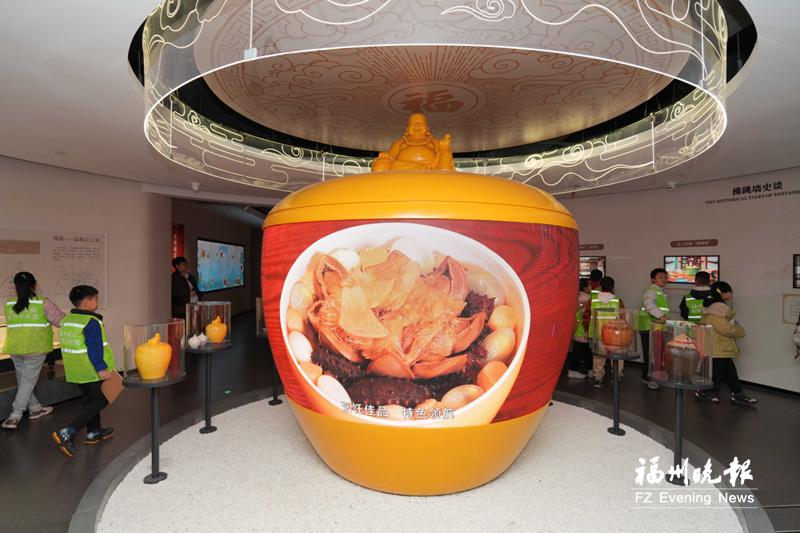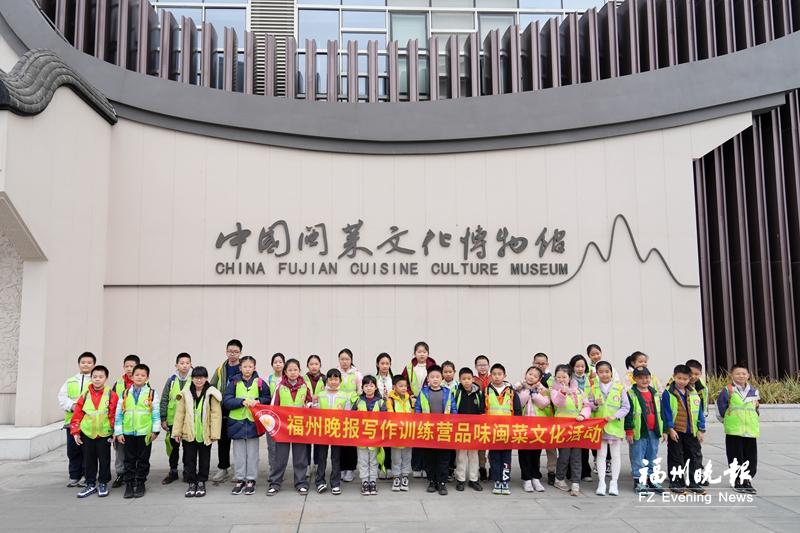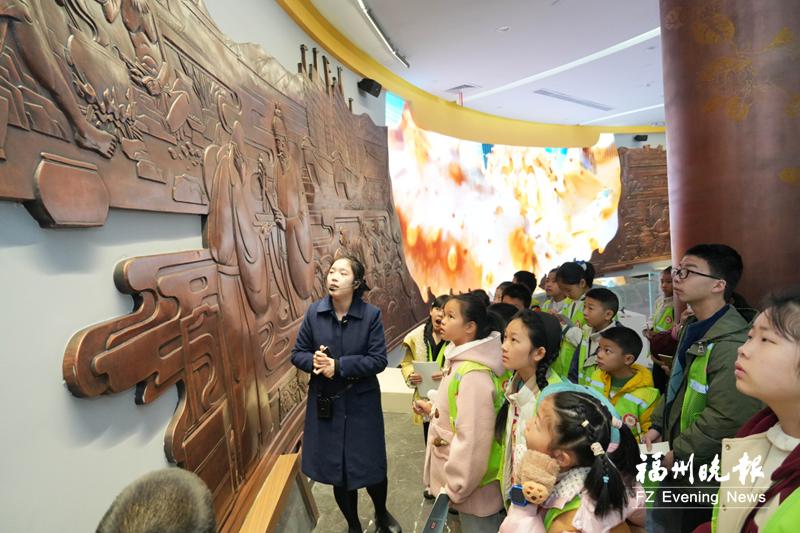Fuzhou Evening News Writing Camp Visits the Fujian Cuisine Culture Museum, Exploring the “Past and Present” of Fujian Cuisine

The large Fotiaoqiang multimedia art installation at the heart of the Fotiaoqiang exhibition hall.
“Wow, this clay pot has twenty tiny openings!” “Fujian cuisine has a Manchu-Han Imperial Feast too!” On January 24, the Fujian Cuisine Culture Museum buzzed with excitement as the young participants from the Fuzhou Evening News Writing Camp marveled at their discoveries. In this museum, which offers both learning and hands-on experiences, as well as visual and culinary delights, the children learned about the history and development of Fujian cuisine and experienced the unique charm of its profound culture.

The Fuzhou Evening News Writing Camp visited the Fujian Cuisine Culture Museum.
Reading the “Classic of Mountains and Seas” through a thousand years of Fujian flavors
What dishes make up the Fujian-style “Manchu-Han Imperial Feast”? Which Fujian dish did Guo Moruo name “Half Moon Sinking into the River” during his visit to Fujian? And which Fujian dish received high praise from the UK’s Queen Elizabeth II? With these questions from the museum guide, the young participants began their exciting journey of discovery at the Fujian Cuisine Culture Museum.
The Fujian Cuisine Culture Museum is the first professional museum in China dedicated to Fujian cuisine. It integrates exhibition and display, tasting experience, culinary heritage preservation, and the promotion and development of Fujian cuisine. The museum houses a collection of more than 1,000 artifacts.
Following the museum guide, the young participants visited the museum’s four permanent exhibition halls: Fujian Cuisine Through the Ages, Authentic Fujian Flavors, Feasts from Famous Restaurants, and Promotion and Inheritance. By carefully examining artifacts and historical materials, they gained a deeper understanding of the geographical distribution, culinary customs, and fascinating stories of the various branches of Fujian cuisine, immersing themselves in the thousand-year-old “Classic of Mountains and Seas” of Fujian flavors. Young participant He Zhuoyan excitedly said, “This is so fascinating! I never realized we share so many eating habits with the ancient people. It feels amazing!”
From the food utensils passed down from the Tanshishan people, who sought food from the river and sea, such as the clay pots, long-necked vases, and rice steamers, to various cooking, dining, and tea utensils from different dynasties, and even the vivid models of Fujian dishes, every item captured the young participants’ attention. Moving among these precious exhibits, they seemed to travel through a time tunnel, witnessing the glorious journey of Fujian cuisine’s growth from its inception to its flourishing.

The young participants were learning about the history of Fujian cuisine.
The historical restoration of famous Fujian cuisine restaurants on the second floor of the museum amazed the young participants. Here, three renowned restaurants, Juchunyuan, Antailou, and Chunfenglou, that once flourished in the history of Fujian cuisine are recreated on the same street. The bustling street, with the flow of carriages and horses from thousands of years ago, is vividly recreated, offering an immersive exhibition experience.
The road paved with thick stone slabs, antique wooden tables and chairs, and neatly lined black-glazed wine jars in the Juchunyuan exhibition area fascinated the young participants. They curiously touched and explored everything, immersing themselves in the vibrant atmosphere of Juchunyuan in its prime.
According to reports, Juchunyuan is one of the surviving time-honored Chinese culinary brands in Fujian Province. Established in 1865, it is known as the birthplace of the world-renowned dish Fotiaoqiang. In 1994, the Juchunyuan Hotel was built on the site of the original Juchunyuan site, breathing new life into the century-old culinary landmark.
This year marks the 160th anniversary of the founding of the Juchunyuan Group. To commemorate the milestone, the group has launched a series of events highlighting its active role in supporting Fuzhou’s push to become a modern international city and its contribution to advancing Chinese modernization in the local context. These initiatives also embody the group’s commitment to growing in step with the city and moving forward in harmony with its progress.
The Fujian Cuisine Culture Museum regularly hosts the “Fujian Cuisine Masters Forum,” where top chefs are invited to share the essence of Fujian culinary culture and techniques through a combination of online and offline models, creating an open, experience-based study tour platform.

The young participants learned to make taro paste.
Preparing the New Year’s Eve feast as little chefs
The large Fotiaoqiang multimedia art installation at the center of the Fotiaoqiang exhibition hall on the second floor of the Fujian Cuisine Culture Museum immediately captured the young participants’ attention. Shaped like an oversized version of the Fotiaoqiang vessel, the installation features curved screens that offer a 360-degree, glasses-free 3D display of the process of preparing Fotiaoqiang.
On January 24, Wei Yuanfei, the representative inheritor of the Juchunyuan Fotiaoqiang making technique and a master of Fujian cuisine, demonstrated the cooking skills behind Fotiaoqiang, the “No. 1 dish of Fujian Cuisine,” to the young participants.
The selection of ingredients for Fotiaoqiang is highly meticulous, with a variety of ingredients subjected to techniques such as steaming, blanching, boiling, frying, and stir-frying, followed by delicate steps like separate and combined simmering, before ultimately creating a fragrant and delicious pot of Fotiaoqiang. Wei Yuanfei’s skilled preparation left the young participants in awe. They were amazed to discover that behind the seemingly simple bowl of Fotiaoqiang lies such a wealth of secrets.
To give the young participants a deeper experience of the charm of Fujian cuisine, a special interactive session called “I’m in Charge of the New Year’s Eve Feast” was organized. With guidance from professional chefs, the young participants became “little chefs” and actively prepared classic Fujian dishes - Lychee Sweet and Sour Pork and Taro Paste.

Fujian cuisine master Wei Yuanfei guided the children in making Lychee Sweet and Sour Pork.
At the event, the young participants were full of enthusiasm. Following the chef’s instructions, they each showcased their skills: some were chopping and washing the meat, some focused intently on coating and shaping, while others carefully poured oil and stir-fried… Thanks to their teamwork, plates of beautifully cooked Lychee Sweet and Sour Pork and Taro Paste were successfully prepared.
Young participant Lin Chenyi said excitedly, “When I get home, I’m going to cook the two Fujian dishes for my family!”
Using imagination to write about Fuzhou flavors
On the afternoon of January 24, the Fuzhou Evening News Writing Camp invited Zheng Chenhong, the Director of the Teaching Affairs Office and Chinese teacher at the Seventh Central Primary School in Cangshan District, to deliver an engaging writing lesson to the young participants.
Based on the experiences of the study tour that day, Zheng Chenhong guided the young participants through the exploration of Fujian cuisine, focusing on the themes of “seeing, making, tasting and reflecting on Fujian cuisine.” With the prompt “I can transform,” she encouraged them to imagine themselves as “tour guides, chefs, Fujian dishes, and ambassadors of Fujian cuisine,” allowing them to fully immerse in the rich flavors of Fuzhou and trace the thousand-year-old history of Fujian culinary culture. Under her expert guidance, the young participants wrote with enthusiasm, producing vivid and imaginative pieces.
“Fujian cuisine is not just one of China’s eight major culinary traditions; it’s a testament to the hard work and wisdom of the Fujian people. We should strive to understand and promote Fujian cuisine culture, while also exploring other traditional cultures, appreciating their unique charm, and passing them on to future generations.”
“Every Fujian dish carries a rich story and reflects a deep cultural heritage. I feel truly proud and lucky to have grown up in a land so rich in culinary heritage. I hope more people will come to know and love Fujian cuisine culture and join me in falling in love with the flavors of Fuzhou.”
At the end of the event, Zheng Chenhong commented on the young participants’ compositions and selected winners for titles of “Best Writer,” “Writing Expert,” and “Observation Expert.” (Fuzhou Evening News Reporters: Quan Yiyue, Zhou Taomao/Text; Bao Hua/Photo)